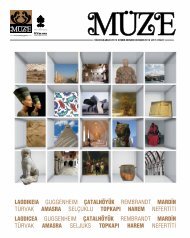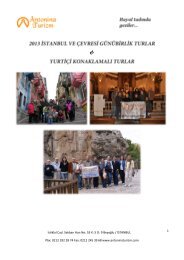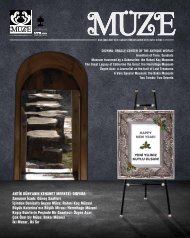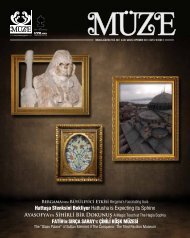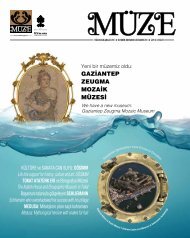TÃRK MÃZECÄ°LÄ°ÄÄ°NDE YENÄ° DÃNEM
TÃRK MÃZECÄ°LÄ°ÄÄ°NDE YENÄ° DÃNEM
TÃRK MÃZECÄ°LÄ°ÄÄ°NDE YENÄ° DÃNEM
Create successful ePaper yourself
Turn your PDF publications into a flip-book with our unique Google optimized e-Paper software.
Efesliler’inince diplomasisi‹lk ola rak Kim mer ler ta ra f›n dan y› k› lan ta p› nak,ye ni den in şa edi lir ken ‘bu yol la ün lü ola ca ğ› n›dü şü nen’ bir akıl hastası ta ra f›n dan bir kez dahay› k›l m›ş t›. Efes li ler, “Ar te mis bir tanrıçaysa, ken dita p› na ğ› n› ne den ko ru ya ma d›?” so ru su üze ri ne,“Bü yük ‹s ken der dün ya ya ge li yor du, do ğu ma yar d›-ma git miş ti” ya n› t› n› ver miş ler di... Do ğu mu na yard›met miş miy di bi lin mez ama Bü yük ‹s ken der y›l larson ra ken te gel di ğin de ta p› na ğ›n onarımı hâlâ devamedi yor du. Efes’ten ve Ar te mis’ten çok et ki le nen‹s ken der, ‘adak ta ş› na ken di ad› n›n da ya z›l ma s›’ko şu luy la ta p› na ğ›n bi ti ril me si ne yar d›m ede ce ği nisöy le yin ce Efes li ler şu ce va b› ver miş ler di: “Bir tan r›,di ğer bir tan r› ya adak ta bu lu na maz...” Ar te mis’inba ğ›m s›z l› ğ› n› ko ru ma ya ça l› şan Efes li ler, in ce birze ka ve dip lo ma tik bir ce vap la, Bü yük ‹s ken der’i k›zd›rma dan so ru nu çöz müş ler di...iyasi ve ticari açıdan dönemin en ünlü kentlerinden biri olan Efes,Meryem Ana, St. Jean ve St. Paul’un gelmesiyle dini bir merkez olarakda dikkat çekmeye başlamıştı. Depremler ve istilalar ile birkaç kezyıkıldıysa da, her yeni gelen halk için kutsal sayıldı. Bu kutsallığın engeçerli sembolü ise Artemis Tapınağı idi.Dünyanın 7 Harikası arasında sayılan Artemis Tapınağı, döneminin en büyük ve en görkemlimermer yapısıydı. Antik çağın mimari eserleri arasında ‘ilk anıt’ olarak da anılan tapınağınyaklaşık 138 metre boyunda ve 70 metre eninde olduğu, 127 sütun üzerinde yükseldiği biliniyor.Tarih boyunca defalarca yağmalanan bu muhteşem yapıdan günümüze ne yazık ki birkaç taş parçası kaldı... Tapınak taşlarının St. Jean Kilisesi, Ayasofya gibi yapıların inşasındakullanıldığı biliniyor. Kazı sırasında ele geçen değerli fildişi, altın ve bronz parçalar ise bugünBritish Museum ve İstanbul Arkeoloji Müzesi’nde sergileniyor.Anadolu’nun anaerkil toplumları kadını baş tacı etmiş, ‘kadın ve ana’yı, simgeleyen tanrıçalaryaratmıştı. Amazonlar’dan başlayan ve büyüyerek yayılan bu inanç, birbirinden muhteşemçok sayıda kutsal alan, tapınak ve tanrıça heykellerinin yaratılmasına neden olmuştu.The subtle diplomacy of thepeople of EphesusFirst destruction of the Temple of Artemis was carriedout by the Kimmerians (Cimmerians) coming fromthe Caucasus. During the reconstruction, Herostratus,a young man and historic arsonist seeking notabilityburned down and destroyed the temple again. To thequestion, “Why Artemis, if a goddess, was not ableto protect her own temple?”, the people of Ephesusanswered, “Alexander the Great was just being born,Artemis went to assist and help his birth”... If she didor not is another question, but, in fact, as years laterAlexander the Great came to Ephesus, the restorationof the temple was still going on. Since Alexander wasdeeply impressed by Ephesus and Artemis, he offeredto help complete the reconstruction of the temple, onone condition, that his name be written on the votivestone. The smart people of Ephesus then answered:“A god cannot offer oblation to another god”.So the people of Ephesus, keen on safeguarding theindependence of their goddess, were able to solve theissue, thanks to their quick wit and subtle diplomacy,without provoking Alexander’s anger...Ephesus, one of the most significant political and commercial cities of its time, came also tobe known as a religious centre due to the stay there of Virgin Mary, St. John and St. Paul.Earthquakes and invasions caused several times the destruction of the city. But Ephesusalways remained a sacred city in the eyes of each new population which settled on its territory.The actual symbol of this holiness was the Temple of Artemis. Considered one the SevenWonders of the World, the Temple was the largest and the most spectacular marble structure ofits time. In historical sources, the temple is described as 138 meters long and 70 meters widemade almost entirely of marble. The Temple consisted of 127 columns, each 19 meters inheight; many of which were carved decoratively. Only a few stone parts remain today on thelocation of this once sumptuous building which was plundered several times throughouthistory... Marble fragments of the temple were used in the construction of structures such asthe St. John Church and the Hagia Sophia Basilica. The valuable ivory, gold and bronzeartefacts discovered in archaeological excavations are now being displayed at the BritishMuseum in London and the İstanbul Archaeological Museum.Women were held in great esteem and honoured by old Anatolian matriarchal civilizations whocreated ‘sacred mother’ figures and worshipped female gods. This tradition, originating fromthe Amazons and expanding in time and geography, paved the way to the creation of varioussacred spaces, temples and goddess statues.From Artemis to Virgin MaryAs the cult of the Mother Goddess in Anatolian homes turned into the worship of Mother56İzmir’in Selçuk ilçesinde yer alan Artemis Tapınağı kalıntıları (solda), tanrıça heykelinin boynundakikolyeden detaylar (üstte) ve Efes Artemis’i. (sağ sayfa)Remains of the Temple of Artemis in the Selçuk district of İzmir (left), details from the necklace onthe goddess statue (above) and Artemis of Ephesus. (right page)



